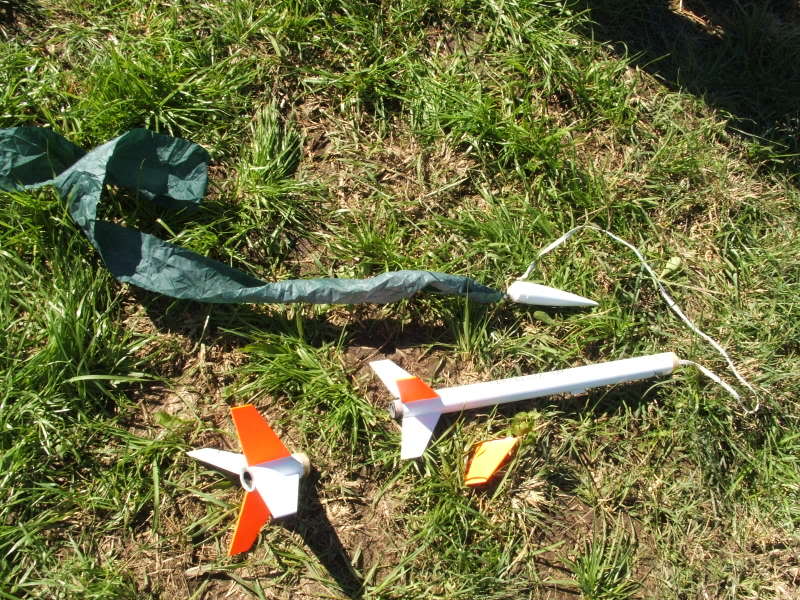Before the Drogue, there was the Streamer.
Ah, the trusty streamer recovery system for model rockets, the unsung hero of amateur rocketry, striking a fine balance between the elegance of parachutes and the brute simplicity of just letting your rocket crash and hoping for the best. Let's delve into the whimsical world of streamer recovery with a smile, shall we?
Advantages:
-
Space Saving Extraordinaire: Streamers are like the Swiss Army knives of the recovery world. No need for a bulky parachute that eats up all the space where you could’ve stashed your snacks (or scientific equipment, but priorities, right?). A streamer tucks in neatly, leaving plenty of room for essentials.
-
Wind, What Wind?: Parachutes have a love affair with the wind, often leading your precious rocket on an unexpected journey to the Land of Lost Rockets. Streamers, on the other hand, are less flirtatious with the breeze, ensuring your rocket lands closer to home base. Perfect for those of us who prefer not to go on a mini safari every launch day.
-
Easier on the Wallet: If you’ve ever wondered how to keep your rocketry hobby from eating into your pizza budget, streamers are the answer. Cheaper than parachutes, they allow for more funds to be allocated to what truly matters: more rockets (or, again, pizza).
-
Simplicity Itself: Deploying a streamer doesn’t require the finesse and timing of a parachute. It’s the equivalent of just throwing your laundry out the window instead of folding it neatly – effective, with a touch of chaos.
Limitations:
-
Speedy Gonzales: Streamers slow down your rocket, sure, but they’re no parachutes. Your rocket still comes down at a brisk pace, which might not be ideal for those fragile payloads (or fragile egos, in case of a crash).
-
Size Matters: If your rocket is on the heftier side, a streamer might just wave at you mockingly as it fails to significantly slow down your descent. Not ideal for those 'go big or go home' projects.
-
The Aesthetic Quandary: Let’s face it, nothing beats the drama and beauty of a parachute deployment. A streamer is more of a practical choice, lacking that Instagram-worthy moment of a parachute gracefully unfurling against the blue sky. It’s the difference between a pragmatic raincoat and a glamorous umbrella.
-
Limited Audience Appeal: To the untrained eye, a streamer might not seem as impressive as a parachute. It’s like trying to explain the charm of a perfectly executed spreadsheet to someone who doesn’t appreciate the finer points of data organization.
IDEAL DESCENT RATE
Calculating a streamer's optimal width and length for your model rocket is a fine art, a dance between physics, mathematics, and a sprinkle of "rocketeer's intuition." Here’s how you can get started on crafting that perfect streamer, ensuring a descent that’s both elegant and efficient, and yes, there are tools and materials to guide you through this noble quest.
Calculating Streamer Dimensions:
-
Descent Rate Formula: The descent rate of a rocket with a streamer can be approximated by considering factors such as the rocket's weight, the streamer's surface area, and atmospheric conditions. However, the exact calculation can get hairy, involving terms like drag coefficients and air density. In simpler terms, a larger streamer (more surface area) will slow down your rocket more, but making it too large could cause it to catch more wind, potentially leading to instability during descent.
-
Streamer Size: A good starting point for a streamer size is to make the length around 10 to 15 times the width. For example, if your streamer is 2 inches wide, a length of 20 to 30 inches could work well. Adjustments might be necessary based on your field tests.
Materials for Streamers:
-
Ripstop Nylon: Lightweight and durable, ripstop nylon is popular for streamers. It’s strong enough to withstand the rigours of rocket recovery and comes in vibrant colours for excellent visibility.
-
Mylar: If you want your streamer to have a bit of shimmer and shine as it descends, Mylar is a great option. It’s lightweight and reflects sunlight beautifully, making your rocket easier to track. Just be mindful that it's not as tear-resistant as ripstop nylon.
-
Polyethylene Terephthalate (PET): Similar to Mylar, PET materials are durable and lightweight, with a bit of shine. They're often used for party streamers, so they can add a festive touch to your rocket recovery.

Estes CC Express with 50mm Ripstop Nylon streamer (and a broken fin). It was the star picket it hit on landing (honest)
When crafting your streamer, the key is to balance weight, durability, and visibility. A streamer that's too heavy might not deploy correctly, while one that's too light might not slow your rocket sufficiently. And remember, the best streamer is one that brings your rocket home safely, allowing it to fly another day.
- Get a lifetime supply of reflective streamers in for only $AUD 19.95any size you wish to cut them to

Experimentation and math are your friends when crafting the perfect descent. Start with the guidelines above, adjust based on your rocket's performance, and don't be afraid to tweak your design. The rocketry community is always a fantastic resource for advice and shared wisdom, so dive into forums and software tools to refine your approach.
ONLINE CALCULATOR

In conclusion, while streamer recovery for model rockets might not have the flair of parachutes or the daredevil allure of free-falling, it strikes a commendable balance between practicality and efficiency. It's the understated hero of the recovery world, perfect for those who appreciate an elegant solution to a high-flying problem.
Plus, it leaves more room for jellysnakes or similar, and isn't that what really matters?
